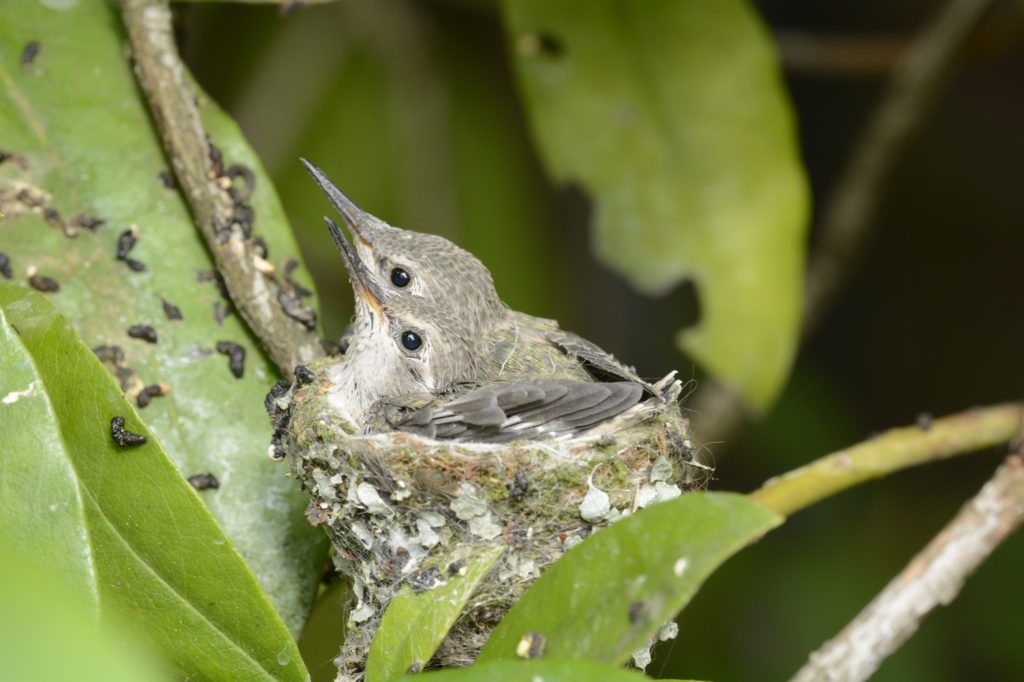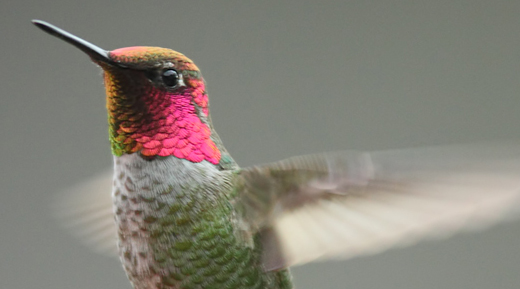he woods hold not such another gem
as the nest of the hummingbird.
The finding of one is an event. – John Burroughs
This is the most common humming bird on the west coast of North America and ranges from northern British Columbia to northern Mexico. This is a moderate sized hummer ranging from 3.9 – 4.3 inches long and weigh up to 0.2 ounces. A standard paper clip weighs about 0.25 oz. Their average body temperature is about 107 degrees F, but they can go into a torpor state to preserve energy and their temperature can drop to 48 degrees. They have an iridescent brownish-green back, a pale gray chest and belly and greenish flanks. The male is distinguished by a crimson/pink head and gorget – the feathers of the throat. Females have a gorget that is smaller and not as noticeable. Females and juveniles have a green crown.
Interestingly, in the early 20th century Anna’s hummingbirds had a much more limited range and bred only in southern CA and northern Baja California. But planting of ornamental, exotic plants in residential areas has allowed them to expand their range significantly. That, and the addition of hummingbird feeders have provided this hummer with an extended food supply. In the Puget Sound area Anna’s hummingbirds are year-round residents. They make extensive use of feeders in winter. During flowering they feed upon nectar using their long bill and extendable tongue and serve a major role as pollinators. They also eat insects they catch in flight or glean off vegetation and have been known to consume tree sap. Nests are built of plant fibers and are located to take advantage of the thermal conditions of overhanging vegetation. These birds are so small and thus have a high surface-to-volume ratio and need to be very conservative about heat loss. The small nests are 1.5 – 2 inches in diameter and the exterior is camouflaged with chips of lichen. Nest materials are held together from the weaving process and using spider silk.
Females will raise the young without help from the male.Male Anna’s hummingbirds sing during courtship – a squeaky/buzzy song. https://www.allaboutbirds.org/guide/Annas_Hummingbird/sounds
Females can have two broods over the season and each clutch consists of an average of 2 eggs, each laid one day apart. The chicks hatch in 14-19 days and then fledge in an additional 18-23 days. Siblings may hang out together until the late autumn.
If you have an acute ear you can hear them chirping away this time of year. The males will dive over their territories and at male intruders. In addition, they have a courtship dive where they rise up to 130 feet and then dive at the female and abruptly rise up in front of her, clocking in at 51 mph. Just as they pull up they fan out their tail feathers and this makes a loud “peep” that sounds like a squeak toy. Short video here: http://thebirdersreport.com/wild-birds/bird-sightings/annas-hummingbird-male-dive-display
I’ve watched Anna’s over at nearby Discovery Park, cycling over and over, up and down to attract a female. I put a feeder on my porch and within an hour they found it and regularly have battles over whose turf this includes. I once watched a male perched atop the plum tree near the sidewalk as another male made wide circles around the house and dove at him at each pass. The perched bird would follow the diver with his gaze as he went by and then he would quickly turn to look towards the corner of the house where he expected his rival to complete his circuit. Once the diver got tired and perched, the original bird got nervous and continually scanned his surroundings not wanting to be surprised.
Anna’s hummingbird is named after Anna Messena who lived from 1802 to 1887. She was the daughter of General Jean Francois Joseph Debelle and married Victor Massena in 1823. She later became the Mistress of the Household to the Empress Eugenie. Rene Lesson, a French naturalist, bestowed the name on this hummer in honor of Anna Messena. Calypte – possibly from the Greek kaluptre – a woman’s veil – and a reference to the gleaming purple head/throat patch, even though this is more prominent on the male.
I have a friend with a passing interest in birds and it seems every time I see her, she has a bird question. I was grocery shopping and when she saw me she marched over with a mission. She grabbed my arm and said “Jim, you have to come over to my house – I’ve got a big surprise for you”. Ok then. So Alka the wonder dog and I went over to Diane’s house and were promptly escorted down the street to an ornamental cherry tree in the planting strip. She pointed up in the branches with a big smile on her face. There, nestled in the crook of a branch was an Anna’s hummingbird sitting on a nest. One of her neighbors pointed it out and it was quite the feat even finding such a well-hidden nest the size of a child’s play teacup. The outside of the nest was decorated with bits of lichen and you could see the spider’s web material in the nest. We retreated after a quick view.
So just keep your ears open for that chirpy-chirpy call and you might be lucky enough to see a courtship or territory dive or two, or three, or…….

